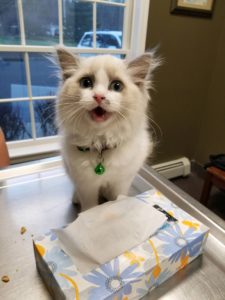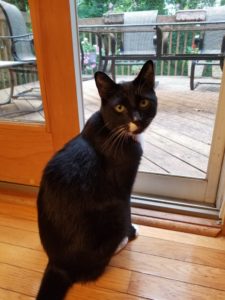J uly: Fireworks, Traveling, Vet Visits, Yikes!
uly: Fireworks, Traveling, Vet Visits, Yikes!
Does your pet look like this?
July is here, and it is one of the scariest times of the year for many pets across the country.
Whether your pet is afraid of fireworks and thunderstorms or vet visits and traveling, there is a way to get through to our non-English speaking companions.
You can help your furry friend feel more comfortable during times of stress and help them face their fears by following some of these simple steps. Sometimes, pets will need medications or products to help them
Acclimation.
We start helping our pets work through their fears with slow exposure training. We use positive reinforcements before there is any fearful stimulations. For example:
- This can be done by slowly exposing the pet to a sound he or she may be afraid of, such as thunder or fireworks. Start by playing an audio of this sound on your phone during a nice, sunny day while giving them some of their favorite treats.
- A pet can be acclimated to their carrier by leaving the carrier out. You can also give your pets treats when they get close to the carrier or place their food on top of a hard carrier. Your pet will no longer associate the “tiny jail” in a negative way since we are forming many happy memories. Your pet will no longer run for dear life every time you take the carrier out of the closet.
- Nail Trims are also difficult for so many pets. You can get your pet acclimated to nail trims by touching their shoulders then legs and feet while providing yummy treats. You can also keep clippers in sight while they are eating or relaxing.
Desensitization.
Systematic desensitization is the process of introducing your pet gradually to a stimulus that would normally cause an undesirable reaction. During an acclimation process a sound or touch stimulus can be increased gradually to produce desensitization. Slow and steady is the way to go here. By working slowly, you may be able to bring trust and your pet will allow a nail trim or ear cleaning.
If your furry friend is afraid of veterinary appointments, we encourage you to stop by with your pet for a “happy visit”. These visits are just quick stops for treats and all the love we can possibly show your pet. Now they will know we are not a threat. Please call ahead
845-986-9900
Medication.
For when it feels like all hope is lost, we turn to medications that reduce anxiety. The use of a combination of medications to help your companion fully relax before coming to their appointment will diminish the stress on your pet and will decrease your stress as the pet parent as well!
It is truly a terrible feeling watching your beloved companion cower in fear when approaching the vet’s office and it makes us feel terrible for them as well. We want everyone’s experience at the vet to be a positive one.
Helpful Products:
- Nutritional supplements: Composure, Zylkene, Purina Calm Probiotic
- Pheromone Sprays: Adaptil for dogs and Feliway for cat
- Devices: Thundershirts, earmuffs and goggles made for dogs and cats.
Useful Links:
About the Fear Free experience: https://fearfreepets.com/fear-free-pet-visits-how-to-take-the-pet-out-of-petrified/
Fear Free for Dogs: https://vcahospitals.com/know-your-pet/fear-free-for-dogs—overview
Fear Free for Cats: https://vcahospitals.com/know-your-pet/fear-free-for-cats—overview
Links for products to turn to:
Thundershirt: https://thundershirt.com/
Noise-Canceling Earmuffs: https://www.amazon.com/Famikako-Protection-Cancelling-Headphones-Fireworks
Calming Cap: https://www.amazon.com/Delifur-Anxiety-Calming-Grooming-Sickness
Composure: https://www.vetriscience.com/behavioral-health.html
About Feliway: https://us.feliway.com/pages/what-are-cat-pheromones
About Adaptil: https://www.adaptil.com/us/Products/ADAPTIL-comforting-messages

 Being the owner of an indoor-only cat has its advantages. As an indoor-cat owner, you do not need to worry about your pet contracting diseases from other fury friends that they may meet during their time outside. You may ask “if my cat lives indoors, why would I need to give him or her a rabies vaccination?” There are a few reasons why a rabies vaccination is so important, even for your indoor-only companion.
Being the owner of an indoor-only cat has its advantages. As an indoor-cat owner, you do not need to worry about your pet contracting diseases from other fury friends that they may meet during their time outside. You may ask “if my cat lives indoors, why would I need to give him or her a rabies vaccination?” There are a few reasons why a rabies vaccination is so important, even for your indoor-only companion.
Recent Comments